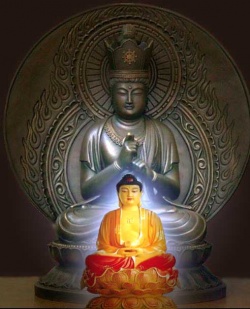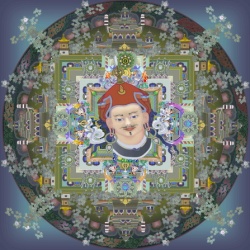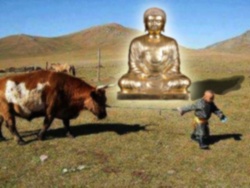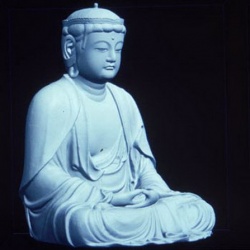Difference between revisions of "Bowing as a Buddhist Practice"
(Created page with " Bowing is found in all Buddhist traditions. There are standing bows, bending at the waist with palms together. There are many sorts of full prostrations,...") |
|||
| Line 1: | Line 1: | ||
| + | <nomobile>{{DisplayImages|3997|1105|3746|1291}}</nomobile> | ||
| + | By [[Barbara O'Brien]] | ||
| − | [[Bowing]] is found in all [[Buddhist traditions]]. There are [[standing]] bows, bending at the waist with palms together. There are many sorts of full [[prostrations]], sometimes [[touching]] one's {{Wiki|forehead}} to the floor, sometimes stretching the entire [[body]] out on the floor. | + | [[Bowing]] is found in all [[Buddhist traditions]]. |
| + | |||
| + | There are [[standing]] bows, bending at the waist with palms together. | ||
| + | |||
| + | There are many sorts of full [[prostrations]], sometimes [[touching]] one's {{Wiki|forehead}} to the floor, sometimes stretching the entire [[body]] out on the floor. | ||
This article will address two basic questions about [[bowing]] as a [[Buddhist practice]] -- why and how. | This article will address two basic questions about [[bowing]] as a [[Buddhist practice]] -- why and how. | ||
| + | |||
| + | |||
Why Do [[Buddhists]] [[Bow]]? | Why Do [[Buddhists]] [[Bow]]? | ||
| − | |||
| − | In {{Wiki|Asia}}, [[bowing]] has many functions and meanings. Most often it is simply an expression of [[respect]]. It is also an expression of modesty, arguably a [[virtue]] more highly valued in {{Wiki|Asian}} cultures than in the [[West]]. | + | In {{Wiki|western culture}}, [[bowing]] is understood as an act of submission to authority or even of self-abasement. Especially where egalitarianism is highly valued nobody bows, even to heads of [[state]], because it is considered demeaning. |
| + | |||
| + | [[Westerners]] who may want to take part in [[Buddhist rituals]] and {{Wiki|ceremonies}} often are uncomfortable with [[bowing]]. | ||
| + | |||
| + | In {{Wiki|Asia}}, [[bowing]] has many functions and meanings. Most often it is simply an expression of [[respect]]. | ||
| + | |||
| + | It is also an expression of modesty, arguably a [[virtue]] more highly valued in {{Wiki|Asian}} cultures than in the [[West]]. | ||
In parts of {{Wiki|Asia}}, such as [[Japan]], [[people]] [[bow]] instead of shaking hands. | In parts of {{Wiki|Asia}}, such as [[Japan]], [[people]] [[bow]] instead of shaking hands. | ||
| Line 19: | Line 32: | ||
In {{Wiki|western religions}}, usually [[bowing]] to an [[altar]] is an act of {{Wiki|worship}} or supplication. This generally is not true of [[Buddhism]], however. | In {{Wiki|western religions}}, usually [[bowing]] to an [[altar]] is an act of {{Wiki|worship}} or supplication. This generally is not true of [[Buddhism]], however. | ||
| − | In [[Buddhism]], [[bowing]] is a [[physical]] expression of the [[Buddha's teaching]]. It is a dropping away of the [[ego]] and whatever we are [[clinging]] to. However, it is not an act of self-abasement but rather an [[acknowledgment]] that self-and-other are not really two separate things. | + | In [[Buddhism]], [[bowing]] is a [[physical]] expression of the [[Buddha's teaching]]. |
| + | |||
| + | It is a dropping away of the [[ego]] and whatever we are [[clinging]] to. However, it is not an act of self-abasement but rather an [[acknowledgment]] that self-and-other are not really two separate things. | ||
When [[bowing]] to an image of the [[Buddha]] or another {{Wiki|iconic}} figure, one is not [[bowing]] to a [[god]]. The figure may represent the teachings, or [[enlightenment]]. It may represent the [[Buddha nature]] that is our original [[self]]. In that [[sense]], when you [[bow]] to a [[Buddha]] figure you are [[bowing]] to yourself. | When [[bowing]] to an image of the [[Buddha]] or another {{Wiki|iconic}} figure, one is not [[bowing]] to a [[god]]. The figure may represent the teachings, or [[enlightenment]]. It may represent the [[Buddha nature]] that is our original [[self]]. In that [[sense]], when you [[bow]] to a [[Buddha]] figure you are [[bowing]] to yourself. | ||
| − | There is a [[Zen]] verse that goes, "Bower and what is [[bowed]] to are [[empty]] by [[nature]]. The [[bodies]] of one’s [[self]] and others are not two. I [[bow]] with all [[beings]] to attain [[liberation]]. To [[manifest]] the unsurpassable [[mind]] and return to [[boundless]] [[truth]]." | + | There is a [[Zen]] verse that goes, "Bower and what is [[bowed]] to are [[empty]] by [[nature]]. |
| + | |||
| + | The [[bodies]] of one’s [[self]] and others are not two. I [[bow]] with all [[beings]] to attain [[liberation]]. To [[manifest]] the unsurpassable [[mind]] and return to [[boundless]] [[truth]]." | ||
| + | |||
| + | |||
How Do [[Buddhists]] [[Bow]]? | How Do [[Buddhists]] [[Bow]]? | ||
| − | |||
| − | Most of the time, [[standing]] bows are done by bending at the waist but otherwise keeping the back and neck straight. Bring your palms together, and remember to not stick out your thumbs but keep them parallel with your fingers. Sometimes the thumbs are tucked in so that the [[hand gesture]] takes the shape of a [[lotus]] blossom. Most of the time your hands will be in front of the lower part of your face, but that's not always the case. | + | The "how" depends on where you are. Different [[schools of Buddhism]] have different [[forms]]. |
| + | |||
| + | If you are visiting a [[dharma]] center or [[temple]] for the first time, it's best to watch closely to see what everyone else is doing. Whatever that is, just do your best to follow the [[form]]. No one will be offended by some newbie clumsiness; we've all been there. | ||
| + | |||
| + | Most of the time, [[standing]] bows are done by bending at the waist but otherwise keeping the back and neck straight. | ||
| + | |||
| + | Bring your palms together, and remember to not stick out your thumbs but keep them parallel with your fingers. Sometimes the thumbs are tucked in so that the [[hand gesture]] takes the shape of a [[lotus]] blossom. | ||
| + | |||
| + | Most of the time your hands will be in front of the lower part of your face, but that's not always the case. | ||
Again, if you aren't sure, watch and copy what others around you are doing. "Correct" [[form]] in one [[temple]] may be all wrong in another one. | Again, if you aren't sure, watch and copy what others around you are doing. "Correct" [[form]] in one [[temple]] may be all wrong in another one. | ||
| − | A common "full" [[bow]] requires dropping to the knees and [[touching]] one's {{Wiki|forehead}} to the floor. Even here, there are variations. For example, in some [[traditions]], the [[prostration]] begins by [[touching]] the folded hands to one's {{Wiki|forehead}} before lowering oneself to the floor, but that's not always the case. Some [[traditions]] teach bow-ers to drop to "all fours," knees and hands, before lowering one's head to the floor, but in other [[traditions]] it's bad [[form]] to press one's palm's against the floor. | + | A common "full" [[bow]] requires dropping to the knees and [[touching]] one's {{Wiki|forehead}} to the floor. |
| + | |||
| + | Even here, there are variations. For example, in some [[traditions]], the [[prostration]] begins by [[touching]] the folded hands to one's {{Wiki|forehead}} before lowering oneself to the floor, but that's not always the case. | ||
| + | |||
| + | Some [[traditions]] teach bow-ers to drop to "all fours," knees and hands, before lowering one's head to the floor, but in other [[traditions]] it's bad [[form]] to press one's palm's against the floor. | ||
| + | |||
| + | In some [[traditions]], once your {{Wiki|forehead}} is [[touching]] the floor hands should be palms up, close to your [[ears]] and parallel to the floor. While the {{Wiki|forehead}} is still [[touching]] the floor, the hands are raised and then lowered. | ||
| + | |||
| + | [[Visualize]] holding the [[Buddha's]] feet in your hands and lifting them above your head. | ||
| + | |||
| + | In other [[traditions]], when your {{Wiki|forehead}} touches the floor your hands may be palms down but close to the head, not spread out any which way. | ||
| + | |||
| + | In [[Tibetan traditions]], it's common to stretch out one's entire [[body]] on the floor. | ||
| − | + | After lowering oneself to "all fours" the bow-er stretches out flat on the floor, face down, with arms stretched out straight ahead in the [[direction]] of the [[bow]], palms outward. | |
| − | + | If you are [[thinking]] of taking part in {{Wiki|ceremonies}} at a local [[temple]] but aren't sure about the [[form]], I suggest calling ahead to see if someone can meet with you to explain [[form]] and [[temple etiquette]] before the {{Wiki|ceremony}}. | |
| − | + | Some [[temples]] and [[dharma]] centers in the [[West]] have regular "newbie" classes for this {{Wiki|purpose}}. | |
{{R}} | {{R}} | ||
http://buddhism.about.com/od/takingrefuge/fl/Bowing-as-a-Buddhist-Practice.htm | http://buddhism.about.com/od/takingrefuge/fl/Bowing-as-a-Buddhist-Practice.htm | ||
[[Category:Bow"]] | [[Category:Bow"]] | ||
Revision as of 11:54, 12 March 2016
Bowing is found in all Buddhist traditions.
There are standing bows, bending at the waist with palms together.
There are many sorts of full prostrations, sometimes touching one's forehead to the floor, sometimes stretching the entire body out on the floor.
This article will address two basic questions about bowing as a Buddhist practice -- why and how.
In western culture, bowing is understood as an act of submission to authority or even of self-abasement. Especially where egalitarianism is highly valued nobody bows, even to heads of state, because it is considered demeaning.
Westerners who may want to take part in Buddhist rituals and ceremonies often are uncomfortable with bowing.
In Asia, bowing has many functions and meanings. Most often it is simply an expression of respect.
It is also an expression of modesty, arguably a virtue more highly valued in Asian cultures than in the West.
In parts of Asia, such as Japan, people bow instead of shaking hands.
A bow can mean hello, goodbye, thank you, or you are welcome. If someone bows to you, most of the time it is impolite not to bow back. Bowing can be very egalitarian.
In western religions, usually bowing to an altar is an act of worship or supplication. This generally is not true of Buddhism, however.
In Buddhism, bowing is a physical expression of the Buddha's teaching.
It is a dropping away of the ego and whatever we are clinging to. However, it is not an act of self-abasement but rather an acknowledgment that self-and-other are not really two separate things.
When bowing to an image of the Buddha or another iconic figure, one is not bowing to a god. The figure may represent the teachings, or enlightenment. It may represent the Buddha nature that is our original self. In that sense, when you bow to a Buddha figure you are bowing to yourself.
There is a Zen verse that goes, "Bower and what is bowed to are empty by nature.
The bodies of one’s self and others are not two. I bow with all beings to attain liberation. To manifest the unsurpassable mind and return to boundless truth."
The "how" depends on where you are. Different schools of Buddhism have different forms.
If you are visiting a dharma center or temple for the first time, it's best to watch closely to see what everyone else is doing. Whatever that is, just do your best to follow the form. No one will be offended by some newbie clumsiness; we've all been there.
Most of the time, standing bows are done by bending at the waist but otherwise keeping the back and neck straight.
Bring your palms together, and remember to not stick out your thumbs but keep them parallel with your fingers. Sometimes the thumbs are tucked in so that the hand gesture takes the shape of a lotus blossom.
Most of the time your hands will be in front of the lower part of your face, but that's not always the case.
Again, if you aren't sure, watch and copy what others around you are doing. "Correct" form in one temple may be all wrong in another one.
A common "full" bow requires dropping to the knees and touching one's forehead to the floor.
Even here, there are variations. For example, in some traditions, the prostration begins by touching the folded hands to one's forehead before lowering oneself to the floor, but that's not always the case.
Some traditions teach bow-ers to drop to "all fours," knees and hands, before lowering one's head to the floor, but in other traditions it's bad form to press one's palm's against the floor.
In some traditions, once your forehead is touching the floor hands should be palms up, close to your ears and parallel to the floor. While the forehead is still touching the floor, the hands are raised and then lowered.
Visualize holding the Buddha's feet in your hands and lifting them above your head.
In other traditions, when your forehead touches the floor your hands may be palms down but close to the head, not spread out any which way.
In Tibetan traditions, it's common to stretch out one's entire body on the floor.
After lowering oneself to "all fours" the bow-er stretches out flat on the floor, face down, with arms stretched out straight ahead in the direction of the bow, palms outward.
If you are thinking of taking part in ceremonies at a local temple but aren't sure about the form, I suggest calling ahead to see if someone can meet with you to explain form and temple etiquette before the ceremony.
Some temples and dharma centers in the West have regular "newbie" classes for this purpose.
Source
http://buddhism.about.com/od/takingrefuge/fl/Bowing-as-a-Buddhist-Practice.htm



